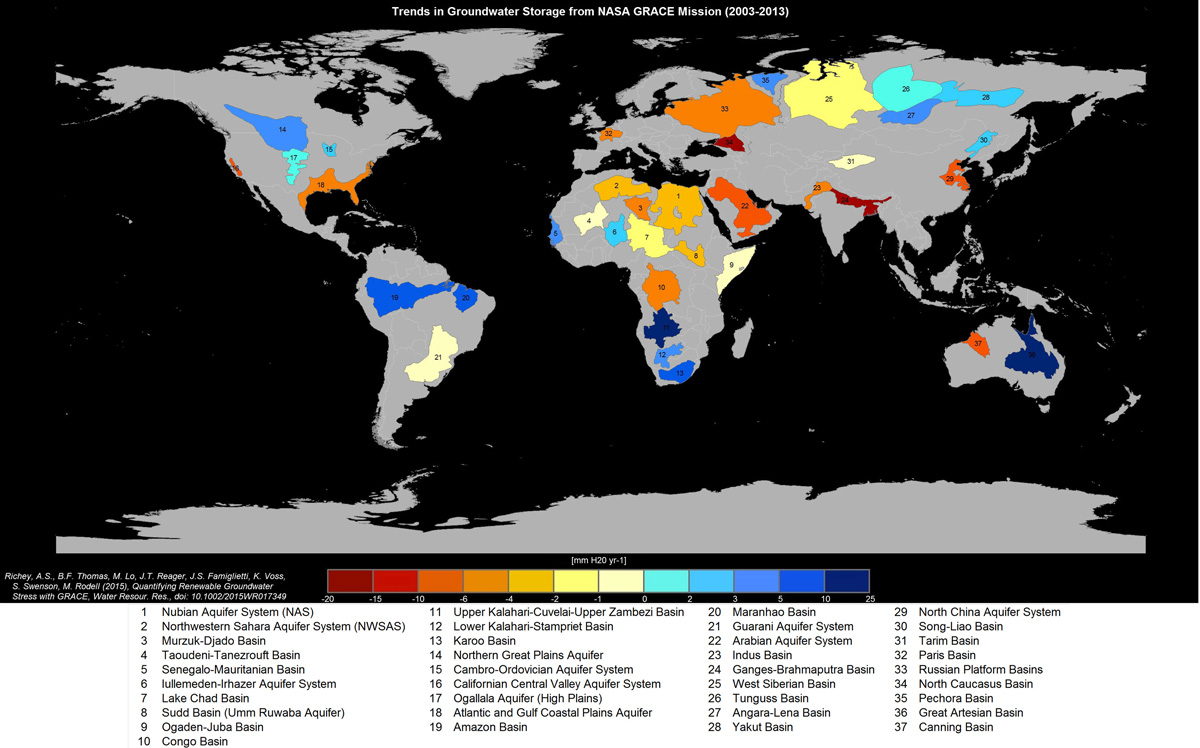-
NASA Data Reveals Most Major Aquifers Depleting Faster Than They Recharge
June 23, 2015 By Linnea BennettResearchers have been warning about future water scarcity for decades, but new data reveals a majority of the world’s largest aquifers are already running out of water.
Using NASA satellite data on aquifer changes from 2003 to 2013, researchers from University of California Irvine published a study in Water Resources Research that shows 21 of the world’s 37 largest aquifers have passed the “sustainable tipping point,” meaning they are depleting faster than they recharge. Thirteen of the 21 aquifers cited fall into the “most troubled” category.
Most aquifers take thousands of years to refill, relying on snowmelt and rain to quench depleted reservoirs. But with climate change and drought pressuring parched communities, agriculture, and energy grids, reliance on groundwater is increasing, draining aquifers faster than natural systems can replenish them.
The geographic diversity of the most stressed aquifers demonstrates how water scarcity is not just a local, but a global problem. Thirty-five percent of humanity depends on groundwater for freshwater, and the 21 depleted aquifers are in developing and developed countries alike. The Arabian Aquifer (Saudi Arabia) and Murzuk-Djado Basin (North Africa) are the most stressed, with little to no hope of recharging, according to the data.
35 percent of humanity depends on groundwater for freshwaterThe report notes that water stress is a potential driver of unrest and regional insecurity. Sixty million people in the Middle East rely on the Arabian Aquifer, and the Murzuk-Djado Basin stretches through parts of fragile, conflict-ridden countries like Libya and Niger. The Indus Basin, shared by India and Pakistan, is another critically stressed aquifer in a fragile region. Hundreds of millions rely on depleting groundwater reserves with few alternatives to turn to.
The NASA data also helps confirm suspicions that groundwater sources are significantly impacted not just by human consumption, but by climate change and water-intensive industries like agriculture, energy production, and mining. In Australia, the Great Artesian Basin is one of the healthiest on record, but the Canning in the west, which hosts far fewer people but prolific mining and oil and gas exploration, boasts the world’s third-highest depletion rate.
The interaction between water, extractive industries, and energy and food production is becoming a choke point in many countries, as explored by the Wilson Center-Circle of Blue Global Choke Point project. China’s rapid expansion of coal burning power plants and coal mining is contributing to the North China Aquifer System’s high levels of depletion. Likewise, India’s Ganges-Brahmaputra Basin defines the far end of the depletion scale, in no small part because of the number of people it supports, but also because of wasteful agricultural practices and growing energy production demands. This has also been the case in California, perhaps the most-publicized instance of groundwater depletion, where just last week, the governor cut water to farmers for the first time in almost 40 years.
Scientists and public officials are exploring desalination and other measures to meet water demands. If depletion trends keep up though, the whole world will be looking to these solutions much faster than anticipated.
Sources: Circle of Blue, The New York Times, Water Resources Research.
Image Credit: University of California Irvine/NASA.
Topics: Africa, agriculture, Australia, climate change, conservation, consumption, data, energy, environment, environmental security, Eye On, featured, India, Libya, livelihoods, Middle East, natural gas, natural resources, Niger, oil, Pakistan, population, U.S., water
 A Publication of the Stimson Center.
A Publication of the Stimson Center.




